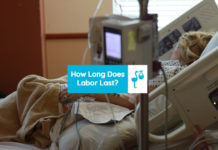While writing your birth plan or counseling your doctor will ask about delayed cord clamping. Most people believe that the cord supplies nutrients until the baby is inside. So once the baby comes out some may consider that the cord is useless. Immediate cord clamping which is cutting the cord is a routine practice for ages. In this article, we will discuss delayed cord clamping and risks associated with it.
Throughout fetal life irrespective of the development the placenta performs the function of major organs. It is the lung, kidney, gut, liver, and gland. All of the baby’s necessities move in and wastes come out through the cord. For this reason, at any point, about 33% of fetal blood is in the cord!
The American College of Obstetricians and Gynaecologists recommended a delay in the clamping of the cord by 1 minute for preterm babies in December 2012. Delayed cord clamping (DCC) gained popularity because of a successful reduction in the rate of intra-ventricular hemorrhage.
After birth during placental transfusion, the blood gradually moves into the baby. Cord clamping is the step where the supply from the cord is cut. Some women wait until the cord stops pulsating and others get it soon after birth.

What is delayed cord clamping?
Delayed cord clamping is a step in neonatal care in which the umbilical cord is cut after birth but cord clamping is delayed for a few minutes. The cord carries an ample amount of blood with nutrients and cells. Whether the woman has a natural delivery or C-section, the benefits of delayed cord clamping hold true.
Even if the baby is preterm delayed clamping serves the purpose of providing basic care. In fact, delayed cord clamping is more beneficial for a premature baby. Not only for the baby, but cord clamping also reduces the chance of postpartum hemorrhage in the mother.
How long to wait before clamping cord?
There is not a particular defined time for clamping and the safe time period is between 1-3 minutes after birth.
When is immediate cord clamping necessary?
When will DCC not be done? Immediate cord clamping is also a necessary step in some situations. When the risks of delayed cord clamping outweigh the benefits, it is not possible to wait. This happens when the baby suffers oxygen deprivation leading to unconsciousness. If the baby needs revival to life by means of external oxygen supply, doctors do immediate cord clamping.
Why is it better not to cut the umbilical cord right away?
Delayed cord clamping assures the return of a major volume of blood to the baby. Along with blood, immune cells, red blood cells, stem cells, oxygen, and nutrients reach the baby. The cord pulsates to pump back the blood from the placenta. Oxygen and nutrients are essential until the baby is able to breathe properly.
The WHO recommendations say that cord clamping not earlier than 1 minute improves the health of mother and baby. The step helps meet the nutritional needs of the baby. Nonetheless in certain conditions such as when your baby needs positive pressure ventilation the cord will have to be cut. Some doctors prefer waiting as long as three minutes after delivery before clamping the birth cord.
What are the benefits of delayed cord clamping?
The benefits of not clamping the umbilical cord include many for both mother and infant. Why is delayed cord clamping recommended? The benefits of delayed cord clamping include:
- A one-third increase in blood volume of the infant
- Reducing the risk of postpartum hemorrhage in the mother
- Better nutritional status of the baby due to extra iron received from cord blood
- More red blood cells in the baby’s circulation within 2 days
- Higher hemoglobin levels up to six months
- Reduced risk of infections and blood transfusion
- Lesser chance of getting anemia after birth due to iron deficiency
- Risk of jaundice due to DCC is lesser than being able to reach a status where the baby can survive the infection
- Stem cells which form different cells, also move through the cord
- Lungs get more blood that allows better adaption to the life outside the womb
Should I add DCC in my birth plan?
The practice of immediate cord clamping allows infant care to start early. Hence, since long doctors have preferred immediate cord clamping. How common is delayed cord clamping? What is the latest advice about DCC? Even today delaying clamping of the cord is more prevalent for preterm babies. In the case of a full-term infant, doctors may still cut the cord after 30 seconds.
World Health Organisation recommendations assert considering 1-minute delay as lower limit for cutting the cord. Presently WHO, NICE and RCOG guidelines are in favor of delay in cutting the umbilical cord after 1 minute. It is a cautionary step for premature & healthy full-term babies.
Do delayed cord clamping benefits favor it?
The delayed cord clamping risks in the case of HIV positive mothers or asphyxiated neonates are considerable. But delaying cord clamping doesn’t lead to the transfer of HIV from an infected mother if there is pre-diagnosis. The WHO guidelines for preventing postpartum hemorrhage say that the benefits of delayed cord clamping outweigh the risk of HIV transmission.
Professionals dealing with pregnant women having HIV risk say that the placenta can lead to the transfer of HIV through maternal blood. However, this is theoretical and HIV testing is mandatory during gestation.
If the mother is positive doctors give her antiretroviral (anti-HIV) drug. Infants of HIV positive mothers also receive a dose of antiretroviral injections. Delaying cord clamping is recommended for infants of HIV positive mothers.
What are the risks of delayed cord clamping?
The risks of delaying in clamping cord are mainly for babies that have asphyxiation. Low oxygen levels require immediate positive ventilation. Similarly, if the cord is bleeding or the delivery had complications the baby needs immediate neonatal care. Other than that if the baby’s heartbeat is less than 60 beats per minute DCC is risky. Some studies show a few long term risks of waiting before cutting the cord. There is an equal number of studies that deny such long-run risks.
1) DCC babies had slightly more cases of jaundice
Delayed cord clamping jaundice risk has a theoretical explanation. The storehouse of iron reaching the baby leads to burdening of the liver. Red blood cells have hemoglobin that breaks down after 120 days lifespan. The end product is bilirubin that gives a yellowish color to eyes and skin during jaundice.
Throughout the fetal life, the placenta takes care of the bilirubin production. After the baby comes out the liver has to mainly do the needful for recycling red blood cell components. If the liver gets an additional burden of excess iron then chances of getting jaundice are higher.
All this is theory and testing serum levels showed no such increase in bilirubin levels.
Jaundice in infants requires the use of phototherapy. And DCC infants have a higher probability to withstand such treatments if they get it by chance.
2) Rapid breathing or breathing failure
The increase in blood volume prevents the lubrication of the walls of lungs. The surfactants prevent the collapse of the airbags in the lungs. When babies receive extra blood they have difficulty in meeting the oxygen demand. It leads to breathing distress and eventually calls for ventilation.
The first thing to note here is, that if the baby has such troubles doctors don’t do DCC. Even if the baby has the cord there are ways to help in breathing in that state.
3) High blood pressure and viscosity
In some cases, the increase in red blood cells in circulation can pose a risk of polycythemia. The increase in elements in the blood can make it viscous and raise blood pressure. On similar lines, it is proposed that DCC babies who have more red blood cells can have hyperbilirubinemia. There is no scientific ground to prove these statements.
Are there risks of delayed cord clamping for the mother?
There are risks of DCC for mother if she already has placental problems. When the placenta lies very low in the womb or attaches deep-seated there can be high-grade bleeding. In such cases, DCC is not the right choice. Placenta accreta or placenta preveria patients generally get immediate cord clamping. In other situations there is no such risk for the mother if her infant gets DCC.
If the mother is bleeding heavily due to the tearing of tissues or some reason a DCC is not safe. The baby will need to go to the neonatalogist because the mother had to undergo a surgery or some other procedure. You can mention about the cases when you would want to be away from the baby.
Can you have delayed cord clamping after the C section?
Yes. Even when the c section is due to emergency or planned you can opt for delayed cord clamping. There is no harm of a DCC after cesarean section. The placenta itself takes time to come out during natural or induced third stage. When your doctor gives an injection for the placenta removal it takes about 5 -10 minutes. Sufficient time is available for the blood to move from the cord to the baby.
Umbilical cord milking: What are the benefits of umbilical cord milking vs delayed cord clamping?
The difference between DCC and milking the cord is primarily the pace of blood transfer from the cord to the infant. When the doctors voluntarily force out the blood from the cord to the infant it is milking. Naturally, the pulsating cord sends the blood to the infant taking some time. Milking the cord is different from delayed cord clamping. UCM is a choice when the cord needs immediate clamping but the baby is premature.





![Why Do You Fast Before Cesarean? [Fasting Before C-Section Facts] Why do you fast before Caesarean?](https://www.pregnanteve.com/wp-content/uploads/2019/03/fast_before_cesarean-218x150.jpg)



